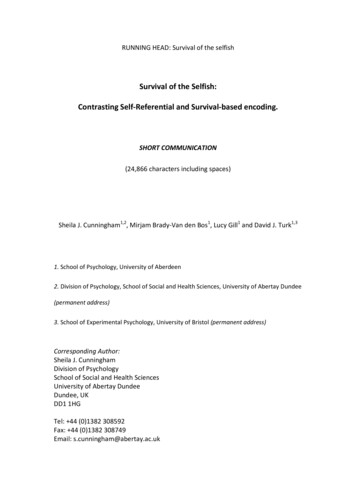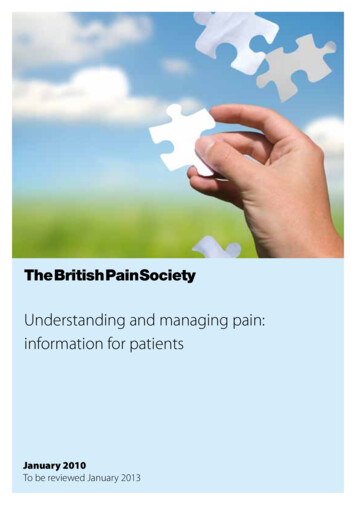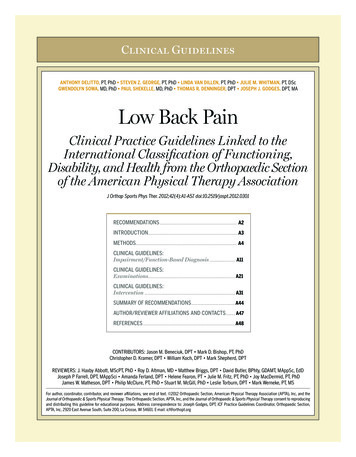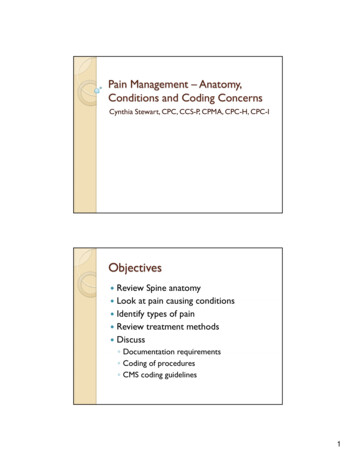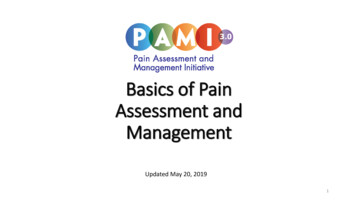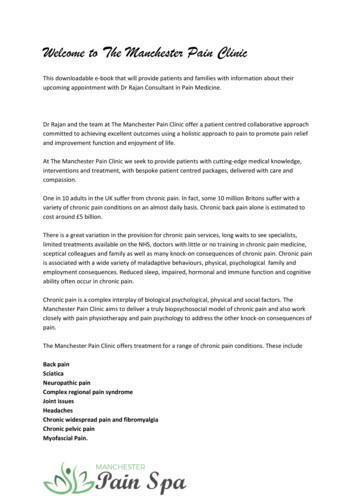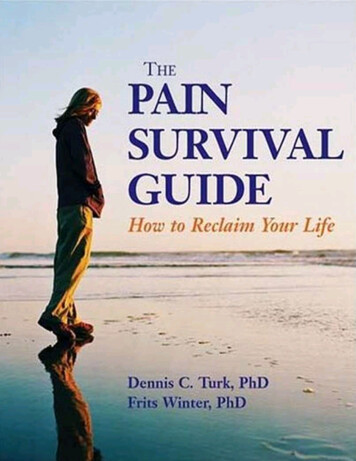
Transcription
The Pain Survival Guide: How to Reclaim Your Life (APA Lifetools)by Dennis C. Turk (Author), Frits, Ph.D. Winter (Author) Paperback: 203 pages Publisher: American Psychological Association (APA) (September 2005) Language: English ISBN-10: 1591470498 ISBN-13: 978-1591470496Book DescriptionIf you suffer from chronic pain, this proven 10-step program brings hope and relief,showing you how gradual changes in specific behaviors can lead to greatimprovements in your ability to cope. Psychologists Turk and Winters’recommendations are based on solid research that shows what works and on theirsuccess with thousands of patients. Unlike the authors of other pain books, theypromise no miracle cures, but they do help you learn "not to let your body push youaround" so life becomes enjoyable again. The key lessons in this book include Uncovering some of the myths about pain and the deceptive ways it fools yourbody into unconstructive behavior Pacing your activity, so you build strengthwithout overdoing or underdoing it Learning how to induce deep relaxation soyou can begin to enjoy life again Dealing with disturbed sleep and chronic fatigue Improving your relations with family and f riends, and soliciting support Changing your habitual behaviors in ways that reduce pain Combating thenegative thinking that often accompanies pain Regaining your self-confidence andtrust in yourself The power of goal-setting and humor Dealing with theinevitable relapses and setbacks once improvement has set in Workbook exercises,behavior logs, and suggested readings help you integrate these lessons into yourdaily life and learn to live well despite pain.
A review ofThe Pain Survival Guide: How to Reclaim Your Lifeby Dennis Turk and Frits WinterWashington, DC: American Psychological Association, 2006. 203 pp.ISBN 1591470498 19.95Reviewed byBeverly FieldThe Pain Survival Guide: How to Reclaim Your Life is a clearly written, patient-focused, behavioral medicine approach to themanagement of chronic pain. As the authors state in the introduction, patients are too often told by their doctors that they must justlearn to live with their pain without being provided with the tools, skills, or assistance needed for managing this task. Turk and Winter'scombined clinical and academic expertise in the field of chronic pain forms the basis for their broad-ranging understanding of the impactof chronic pain on a person's life. They address pain, as well as the multiple losses that are often the consequences of pain and physicallimitations, and provide guides for obtaining the tools and skills needed to reclaim a meaningful life. Topics related to areas of lossinclude physical losses (such as deconditioning, sleep disturbance, and weight changes), social consequences (such as changing roleswithin family and the impact of pain on friendships), and personal losses, including changes in feelings of self-worth and self-image.This guide is divided into 10 sections, or lessons. Each lesson has a specific focus that includes background information on theproblem being addressed, skills for managing the problem, anticipated “traps” or setbacks, and assignments for incorporating the skillspresented. In addition, supplemental reading for each lesson is provided, as is research supporting the cognitive-behavioral approach formanagement of pain. The first lesson is an introduction to chronic pain and includes an introduction to theories that guide understandingand treatment of pain, common myths about pain, and types of treatments available. Patients are actively brought into the process withan opening assessment of the multiple factors that may be influencing their pain. The second through fourth lessons deal with pacingactivity and building endurance, how to use rest and relaxation techniques, coping with fatigue, and developing meaningful activities todeal with boredom and feelings of meaninglessness. The fifth through eighth lessons address the impact of pain on family and friends(ways to improve communication, dealing with intimacy and relationships); how behavior is changed; how thinking influences painperception and coping; and ways to improve self-confidence (acknowledging limitations, learning to speak assertively, and developingproblem-solving skills). The ninth and tenth lessons summarize gains and address ways to deal with relapses and flares.The Pain Survival Guide could be used independently as a self-management resource by a person with chronic pain. It is easy toread, well organized, and free of medical or psychological jargon. Theories, such as positive reinforcement and cognitive restructuring,are briefly and clearly explained in the lessons directed toward changing behaviors, thoughts, and feelings. This guide is also appropriatefor use with other treatment approaches, such as physical therapy, prescription medications, and medical procedures. The Pain SurvivalGuide could be used by a physician who finds that previous attempts to manage pain have been inadequate to the extent of his or herpatient's problem. Or a therapist, working with a patient with chronic pain, might use The Pain Survival Guide as a basis for individual orgroup therapy sessions. With a pain patient referred for treatment of depression, it would be important to understand and treat themultiple sources from which depression might arise, and these factors are clearly laid out in this book.Turk and Winter's guide is an excellent addition to the patient-focused manuals available, such as Jamison's (1996) Learning toMaster Your Chronic Pain and Caudill's (2002) Managing Pain Before It Manages You. What it provides to a greater extent than the otherguides is a more extensive discussion of the bases or theories underlying the problems being addressed and more emphasis on themultiple factors that influence each lesson area. If there is any negative to this book, it is the sheer density of information. As I readthrough the guide I couldn't help but wonder whether a patient, paralyzed by feelings of hopelessness and apathy, wouldn't find thedensity of information daunting. On the other hand, a person struggling with chronic pain who can work through this guide slowly andpersistently will find understanding, a sense of hope, and a well-defined path to reclaiming life.ReferencesCaudill, M. A. (2002). Managing pain before it manages you. New York: Guilford Press.Jamison, R. N. (1996). Learning to master your chronic pain. Sarasota, FL: Professional Resource Exchange.PsycCRITIQUES1554-0138February 8, 2006 Vol. 51 (6), Article 5 2006 by the American Psychological Association
Table of ContentsLESSON 1: Becoming Your Own Pain Management Expert . 9The Nature of Chronic Pain . 10The Gate Control Theory . 14Common Myths About Pain . 16Treatments for Pain . 17The Purpose of This Program . 24The Importance of Action . 25Activities That Can Help . 26LESSON 2: Activity, Rest, and Pacing . 31Move It or Lose It! . 32Move Smarter, Not Harder . 34How to Pace Yourself . 39How Pain and Inactivity Have Affected You . 45Common Problems When Becoming More Active . 47Activities That Can Help . 48LESSON 3: Learning to Relax. 51The Energy Balance . 52Learning to Relax . 57Systematic Muscle Relaxation . 59Exercise 3.1. Controlled Breathing . 61Attention Diversion . 62Creating a Pleasant and Safe Home Environment . 65Really Enjoying Food . 66Enjoying Nature and Other People . 67Giving Yourself Room to Breathe . 67Summary . 68Activities That Can Help . 69Appendix 3.1 Progressive Muscle Relaxation . 71Appendix 3.2 Example of a Pleasant Image . 73LESSON 4: Are You Always Tired? Ways to Combat Fatigue . 75Your Body's Energy System . 76Emotional Tiredness . 76Physical Tiredness . 77Nutritional Tiredness . 79Other Ways of Improving Sleep . 81A (Necessary) Return to Pacing . 84The Importance of Realistic Expectations in CombatingFatigue . 85Diversion, Priorities, and Control . 87Activities That Can Help . 89LESSON 5: Don't Let Pain Ruin Your Relationships! . 93The Importance of Communication . 93Sharing With Family and Friends . 96Decoding Communication Problems . 97Pain Causes Negative Feelings .100
Improving Communication .100Giving and Getting Respect .100Behavior as Communication .102Intimacy .105Relationship Maintenance .107Summary .108Activities That Can Help .108Appendix 5.1 Pain Rating System .110LESSON 6: Changing Behavior .113Reward Desirable Behavior! .114The Laws of Learning and You .118Preparing for Behavioral Change .125Summary .126Activities That Can Help .126LESSON 7: Changing Thoughts and Feelings .129Method 1: Thinking Differently .129Method 2: Behaving Differently .135Method 3: A "Must" is Not a Need! .137Method 4: Stopping at the Right Time .140The ABCD Model .141How to Use the ABCD Model in Your Own Life.142Activities That Can Help .145LESSON 8: Gaining Self-Confidence .149A Daily Inventory .150Learning to Love Yourself .150Controlling the Things You Can Control .154Learning to Problem Solve .157Learning From Others .159Summary .160Activities That Can Help .161LESSON 9: Putting It All Together .163Pain: Past, Present, and Future .163Motivation 201 .167The Seasons Change, and So Do You .167The Mechanics of Goal Setting .168Summary .169Activities That Can Help .169LESSON 10: The Importance of Maintenance and "Setbacks" .171The Top Three Pain Management Principles .171The "What, How, and When" of Staying Involved in Life .176Managing Flare-Ups .176A Final Word .178Key Points to Remember .179Activities That Can Help .180
L E S S O N 1Becoming Your OwnPain Management Expert"Grant me the serenity to accept the things I cannot change,courage to change the things I can,and wisdom to know the difference."—Serenity Prayer, Rheinhold Neibuhr reryone has pain at times. The reassuring thing about most pain is that it will usuallyjo away with time. A sports injury and its resulting pain, such as an elbow injuredduring a casual game of tennis, will eventually heal with resting that part of the arm. Oncethe pain has ceased for the weekend tennis player, the suffering is soon forgotten.For most people, it is unthinkable that pain will never go away. That is part of why theydon't understand the plight of those who experience chronic pain.Even those with chronic pain don't like to think of it as such. If we admit to havingchronic pain, it means admitting it will last a long time or perhaps will never go away at all.It's scary to think that way, and such thinking can also make the pain seem even worse.If doctors have been stymied and called your pain "treatment-resistant" or "chronic,"you may have asked yourself, "Have the doctors been defeated by my pain? "Have they givenup on me?" Am I condemned to a life of inactivity, anger, helplessness, suffering, and despair?"These are normal but very depressing thoughts!The good news is that many thousands of people have proved that despite the presenceof pain, they do not have to give in and give up control of their lives. They have found amiddle ground. They are not denying that their pain is chronic, but they are also steppingup to the plate and confronting their pain. They have found a balance between acceptanceand change. The Serenity Prayer with which we began this lesson seems particularly applicable,especially the words serenity, courage, and most important, wisdom.Our patients begin to no longer think of themselves as patients but rather as pain selfmanagers. They have gradually learned what they are capable of doing, and they have donethat and gained even more capability. Although once pain held them completely in its grip,
10THE PAIN SURVIVAL GUIDEthey have found ways to overcome its debilitating effects. They have become smarter, moreclever, and wiser. They have gained control over their pain and their lives. As you workthrough this book, it will become clear to you that while others can support you, you mustbecome your own expert on your pain and your own pain manager.In the coming lessons, we will coach you to become that expert. You already know morethan you think. Nobody knows your pain as well as you do, not even the finest doctors inthe world. Nor does your neighbor with a similar ailment know your pain as well as youknow it, because pain is an incredibly personal experience.It is your personal expertise in pain that will be our basis in coaching you. It will helpus to help you design a plan to manage your pain, which is as unique as you are. In thislesson, you will learn more about pain so that you can better understand your own. Knowledgeis power!The Nature of Chronic PainWe have used the phrase chronic pain several times already in this book, but what exactlydefines pain as chronic? Usually, pain following overuse or injury is considered to be chronicwhen it continues to interfere with living or does not become much less intense after theexpected period of healing (i.e., medical estimates as to how long it takes for tissue damageto heal following an injury or overuse). Pain is also considered chronic when it is related toa progressive disease (such as arthritis or cancer).For most acute injuries, such as as a sprained ankle, the expected period of healing isfrom several weeks to several months. For back injuries, the pain may last longer, but withproper care should remit over a period of time. For pain following minor surgery, the expectedperiod of healing might only be a few days.Thus, there is no exact time at which pain ceases to be acute and becomes chronic. Butmost of us know when we have a chronic disease such as arthritis. We also tend to knowwhen pain from an injury has persisted well beyond the expected course. And, we can allagree that pain has become chronic when it alters our lifestyle and serves no useful purpose(more about the purpose of pain later in this lesson).Chronic Pain Is Very Common—All Too Common!When we have chronic pain, it is easy to feel as if we are alone. The reality is, however, thatchronic pain is unfortunately very common. Recent surveys provide some rather surprising,and to many distressing, information (see Exhibit 1.1).
Becoming Your Own ExpertExhibit 1.1.11The Magnitude of the ProblemIn the United States alone, over 11 million people experience migraine headaches;23 million people report the presence of chronic back pain;37 million people indicate they have pain associated with arthritis;3 to 6 million people are diagnosed with fibromyalgia;3.5 million people experience pain associated with cancer and its treatment;annual costs (health care, disability, lost productivity) of chronic pain may exceed 125 billion this year.Although pain is a personal experience, you have a lot of company when it comes toexperiencing chronic pain. Of course, knowing that such large numbers of others experiencechronic pain does not diminish your suffering. But at least there is some solace in knowingthat you are not alone. And there is even more solace in knowing that many of these peoplehave learned to live fulfilling lives despite their pain. You can too!The Usefulness of PainAcute pain can be useful as a warning that you have gone beyond your body's limitations,but the pain signaling system is unreliable at times. Often, harm is occurring within thebody and no pain is experienced. Even more often, harm cannot be detected with classicmedical tests, but pain is clearly present.Harm, but No PainOften, people with cancer feel quite healthy until their disease progresses into a very seriouscondition. A lump that is not noticeable to anyone but a well-trained physician can bediscovered during a routine medical check up and turn out to be malignant. The patient inquestion may feel no pain at all, and yet something life-threatening is occurring in his orher body. Following successful surgery or chemotherapy, he or she may still experience painor other kinds of discomfort, but the pain is not caused by the tumor but by the treatment itself.Likewise, there are a substantial number of people who do not report pain, but whendiagnostic tests like x-rays are performed, significant pathology is present. In fact, studies
12THE PAIN SURVIVAL GUIDEhave shown that when sophisticated diagnostic procedures (such as magnetic resonance images[MRIs], and computed axial tomography [CAT scans]), are performed, as many as 35% ofpeople who have no reported symptoms and no pain at all, show significant physical pathology.This is pathology that we might reasonably expect to cause pain! Contrary to what we mightbelieve, there is not a close relationship between the amount of pain we feel and the amountof harm occurring in our bodies. That's why it is important to have routine medical check ups!Pain, but No Objective EvidenceThere are many common chronic pain conditions such as back pain, whiplash (resultingfrom neck injuries frequently following motor vehicle accidents), fibromyalgia (a painfulmusculoskeletal condition characterized by widespread and persistent pain and fatigue), andmigraine and tension headaches in which little evidence of physical pathology can be detected.For example, in up to 85% of people with back pain, doctors are unable to determine aphysical cause. Yet, such pain may be severe, causing significant distress and disability. Inthe case of chronic headaches, there is rarely any identifiable tissue damage that can explainthe experience of pain, yet these people suffer enormously. In whiplash injuries and fibromyalgia, no physical cause can be identified in a substantial majority of the people who reportthat their pain is severe and greatly diminishes the quality of their lives.Some people for whom medical tests do not show a cause for their pain may be toldoutright that their pain is not real. Or, more often, they receive subtle signals from doctors,family members, or insurance claims managers that they are exaggerating normal aches andpains. You may have experienced such skepticism yourself. We do not agree with suchmessages. All pain is real to the person who experiences it!Same Injury, Same Treatment, Different ResultsAnother puzzling aspect of pain is the fact that people with the same medical diagnosis (eitherinjury or disease) often respond quite differently to identical treatments. For example, threepeople may have surgery for a problem that is apparently caused by a dysfunction of a spinaldisc (such discs function as "shock absorbers" in the body). Following surgery, one patientis very happy because the pain is gone. Another is disappointed and surprised to find thepain feels the same. A third person is very distressed because the pain feels even worse thanbefore the surgery. These are common experiences for people who have undergone discsurgery. The results suggest that factors other than damage to the disc, bones, nerves, andmuscles associated with the spine must be contributing to the pain experienced after surgery.
Becoming Your Own Expert13Misleading PainThere are also a number of pain disorders in which the pain system gives a misleading signal.You feel pain in one place, but the damage is someplace else. Doctors call this "referred"pain. The pain at one place in the body refers to damage somewhere else in the body. Forexample, pain on the side of the biceps in the arm may indicate a frozen shoulder syndrome.Back pain may be caused by problems in the stomach or pelvis.Finally, there are "strange" pain experiences that occur following amputation or afterdamage to the spinal cord. Quite commonly, pain is felt as ifit were in the amputated limb—a limb that is no longer attached to a body! This is referred to as phantom-limb pain. However,whereas the limb may be phantom, the pain certainly is not!Pain is also frequently felt in the lower limbs of people who have had a spinal cord injuryand are paralyzed. Some of these individuals experience real pain in their legs although theycannot move them. This pain is counterintuitive, because through damage to the spinal cord,the nerve pathways linking the spinal cord to the brain are completely severed. Theoretically,no messages signaling injury can travel along the nerves to ever reach the brain. Thus, thereshould be no pain signals registering in the brain and therefore, there should be no pain.Yet, a significant proportion of people with spinal cord injuries do, in fact, feel severe pain.How can this be? It is as if the plug has been pulled from the radio but the music is stillplaying. Pain is indeed one of the most mysterious of physical maladies.Take Your Pain SeriouslyExtreme pain is real, even if there is no "objective" (i.e., observable) cause for it as definedby current medical diagnostic techniques. The same is true for depression, for example. Aperson can be depressed or suicidal when his or her whole life is going well, and nothingwill show up on any medical test. And this has been true for decades. The Russian authorTolstoy once wrote, "I am very rich and famous; millions of Russians read my books. Ipossess a big farm, a wife and five children and the only thought that haunts me is: shall Iuse a rope or a gun to end it all?"Many people with chronic pain become depressed. They have to take that seriously aswell as their pain and consult a mental health professional when these feelings interfere withtheir quality of life.The same is true with anxiety. A person in no objective danger can break out in a sweatand feel as if he or she is going to die. That is why it is good to once again repeat thatfeelings of fear, sadness, and pain can be extremely intense, even if they seem out of proportionto the so-called objective facts. When chastising themselves for having pain and thinking ofthemselves as weak, individuals with anxiety or depression often think they are "going crazy."
14THE PAIN SURVIVAL GUIDENeither the pain sufferer nor the person suffering from anxiety or depression is weak orcrazy. What they have in common is that they must search for a solution rather than focusingon what may or may not be the cause.Seek the Solution, Not the CauseIn cases of chronic pain, both the sufferer and the doctor initially seek to find the cause ofthe pain. By this, doctors usually mean the physical cause. Long after a second opinion hasbeen sought and the doctor has "given up," the patient may continue to try to find the causeof the pain.However, the main question is not, How or why did I get the pain? The critical questionis, What can I do to manage my pain so that I can get on with my life?We will discuss the role of factors other than physical damage in pain later in this book.Here, we discuss some of them briefly in the context of Gate Control Theory.The Gate Control TheoryImagine a door or gate in your spinal cord. Before your pain became chronic or before youhad a progressive disease such as arthritis, usually this gate was closed and you did not feelpain. If you had an injury or some other type of obvious physical damage occurred, signalswere sent along your nerves (the wiring of our bodies) to the spinal cord. These signalsopened the gate and allowed information about the injury or damage to your body to reachthe brain. This is where these signals are interpreted, with the result being the feeling ofpain. In these cases, as you healed sometimes the pain was better and sometimes it was worse.It depended on how far open or closed the gate was.In Exhibit 1.2 we have included a summary of the different factors that are known toopen and close the pain gate.The idea of a pain gate that can be opened and closed will help you understand thatpain, especially chronic pain, cannot simply be eliminated by cutting out a painful body partor cutting nerves. In the past, nerves were cut in the hope of blocking pain. Unfortunately,all too often the surgical procedures created more problems than they solved. The nervoussystem does not operate like a simple cable system that can just be clipped and repaired. Itis a living system that is continually changing and adapting to new circumstances andnew information.In addition to this information, it's helpful to know about common folklore about painthat can actually decrease your chances of living a zestful life. A couple of these ideas we
Becoming Your Own ExpertExhibit 1.2. Summary of the Factors That Can Open and Close thePain GateFactors that can open the pain gateO Physical factorsft Extent of injuryft Inappropriate activity levelO Emotional stressftftftftDepressionWorry/fearTensionAngerO Thoughtsfl Focusing on the painft Boredom due to minimal involvement in life activitiesft Nonadaptive attitudes and expectations ("It will never end!" "I'm helpless andhopeless!")Factors that can close the pain gateO Physical factorsIIIIIIIIMedicationCounterstimulation (heat, rubbing)Appropriate activity levelRestO Relative emotional stabilityII RelaxationII Positive emotions (happiness, optimism)O ThoughtsII Life involvement, increased interest in life activitiesII Concentration/distraction II Adaptive attitudes/positive thoughts and feelings ("I can control my feelings." "I canreduce my level of muscle tension." "I am capable of doing many things despite mypain.")15
16THE PAIN SURVIVAL GUID
The Pain Survival Guide: How to Reclaim Your Life by Dennis Turk and Frits Winter 19.95 Washington, DC: American Psychological Association, 2006. 203 pp. ISBN 1591470498 Reviewed by Beverly Field The Pain Survival Guide: How to Reclaim Your Life is a clearly written, patient-focused, behavioral medicine approach to the management of chronic pain.




